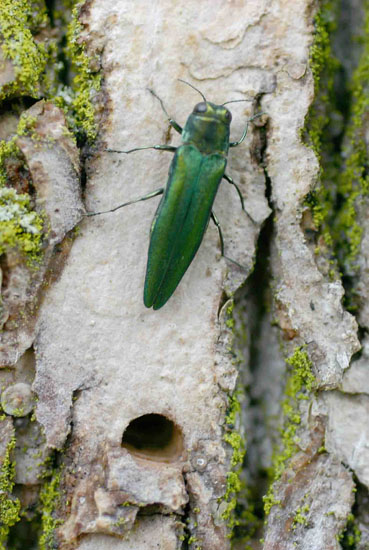Issue 3, May 15, 2017
Emerald Ash Borer
Emerald ash borer adults are emerging in southern and central Illinois and will probably do so in northern Illinois in about two weeks. They will continue to emerge over several weeks. Now is the time to apply systemic insecticides to control this pest if emerald ash borer has been found within 15 miles.

The systemic insecticides azadirachtin (Azatin), dinotefuran (Safari), emamectin benzoate (Tree-Age), and imidacloprid (Merit), provide excellent control of emerald ash borer by killing adults feeding on ash leaves. This is probably the major method of control with the exception of emamectin benzoate which has been shown to also be very effective in killing larvae within the tree.
Many female beetles rely on leaf-feeding after emergence to mature their ovaries prior to egg production. It is likely that male beetles benefit by leaf-feeding as well. Although emerald ash borer beetles can fly one-half-mile or more, it appears that they do not fly as far if suitable hosts are close at hand. Long-distance flights apparently are most common when an area's trees are heavily infested.
Heavily damaged, untreated trees are likely to produce large numbers of beetles that are likely to fly to nearby healthy, treated trees. However, because heavily damaged trees typically have few leaves, those flying to treated trees are likely to feed on the treated trees' leaves and be killed before laying eggs. This is borne out by many instances of healthy, treated trees surviving while nearby untreated trees die.
Pollinating insects generally do not visit wind-pollinated trees such as ash. The pollen of wind-pollinated plants typically does not contain the high protein content found in pollen of insect-pollinated plants. However, ash produces large quantities of pollen when local higher quality sources such as dandelion and other spring flowers might not be present. When this occurs, up to 30% of the pollen collected by honey bees during this time has been found to be ash. Because systemic insecticides are likely to enter pollen, we recommend treating after ash leaflets have expanded to at least three-quarters of full size. By that time, ash have completed pollination, greatly reducing the potential of harm to honey bees and other pollinators. Three-quarter leaflet expansion has occurred in southern and central Illinois. (Phil Nixon)
Author:
Phil Nixon